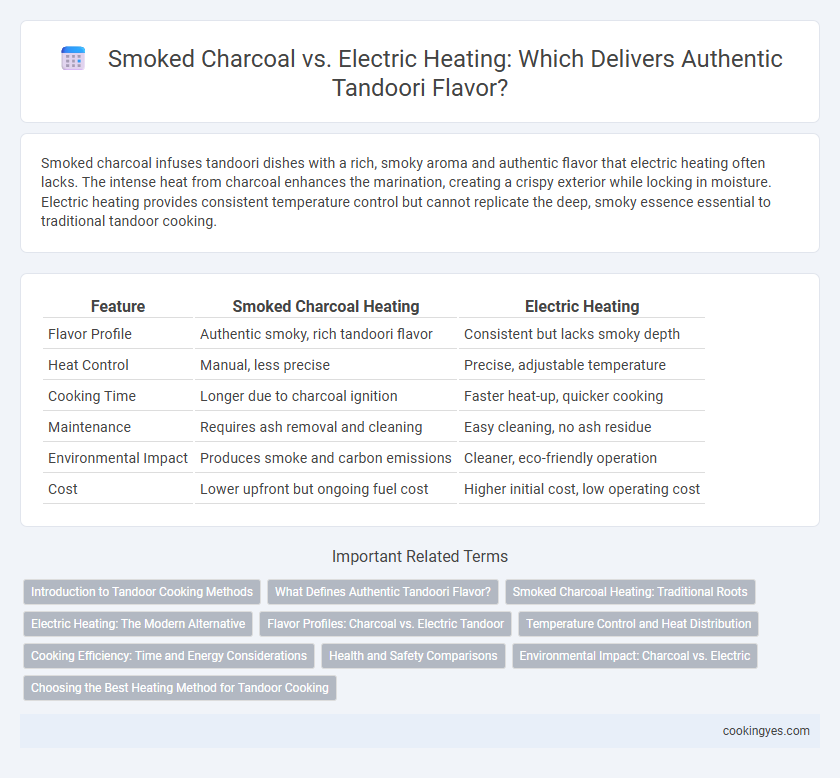Smoked charcoal infuses tandoori dishes with a rich, smoky aroma and authentic flavor that electric heating often lacks. The intense heat from charcoal enhances the marination, creating a crispy exterior while locking in moisture. Electric heating provides consistent temperature control but cannot replicate the deep, smoky essence essential to traditional tandoor cooking.
Table of Comparison
| Feature | Smoked Charcoal Heating | Electric Heating |
|---|---|---|
| Flavor Profile | Authentic smoky, rich tandoori flavor | Consistent but lacks smoky depth |
| Heat Control | Manual, less precise | Precise, adjustable temperature |
| Cooking Time | Longer due to charcoal ignition | Faster heat-up, quicker cooking |
| Maintenance | Requires ash removal and cleaning | Easy cleaning, no ash residue |
| Environmental Impact | Produces smoke and carbon emissions | Cleaner, eco-friendly operation |
| Cost | Lower upfront but ongoing fuel cost | Higher initial cost, low operating cost |
Introduction to Tandoor Cooking Methods
Tandoor cooking relies heavily on the heat source to impart its characteristic smoky flavor and texture to dishes. Smoked charcoal provides intense, uneven heat that infuses food with authentic smoky aromas, while electric heating offers consistent temperature control without the traditional smoke essence. Understanding these differences is key to achieving the desired tandoor flavor profile in various culinary applications.
What Defines Authentic Tandoori Flavor?
Smoked charcoal imparts a rich, smoky aroma and intense heat essential for achieving the authentic tandoori flavor, enhancing the marinade's spices with a subtle char. Electric heating elements provide consistent temperature control but often lack the depth of smokiness and traditional flavor complexity generated by charcoal combustion. The defining characteristic of authentic tandoori flavor lies in the interplay of high heat, smoky undertones, and slow roasting, which smoked charcoal uniquely delivers.
Smoked Charcoal Heating: Traditional Roots
Smoked charcoal heating preserves the authentic tandoor flavor by imparting a distinct smoky aroma and intensity that electric heating cannot replicate. The high, uneven heat generated by charcoal enhances the texture and taste of tandoori dishes, creating a crispy exterior while locking in moisture. Deeply rooted in tradition, charcoal-fired tandoors maintain the genuine culinary experience essential to classic Indian cuisine.
Electric Heating: The Modern Alternative
Electric heating in tandoors offers a consistent temperature control that enhances the cooking process while preserving the traditional smoky flavor through advanced heating elements designed to mimic charcoal smoke. Unlike smoked charcoal, electric heating eliminates harmful emissions and reduces cooking time without compromising the characteristic tandoori texture. This modern alternative ensures precise heat distribution, resulting in evenly cooked dishes with a subtle smoky aroma favored in contemporary kitchens.
Flavor Profiles: Charcoal vs. Electric Tandoor
Smoked charcoal tandoors impart a rich, smoky aroma and deep, complex flavors due to the natural wood and coal combustion, enhancing the traditional taste of tandoori dishes. Electric tandoors provide consistent and controllable heat but lack the authentic smoky essence, resulting in a milder and less intense flavor profile. Charcoal heating remains the preferred choice for delivering the quintessential smoky notes and crisp texture essential to classic tandoori cuisine.
Temperature Control and Heat Distribution
Smoked charcoal offers intense, smoky flavors and reaches higher temperatures quickly, but temperature control can be challenging due to uneven heat distribution. Electric heating provides precise temperature control and consistent heat distribution, ensuring even cooking but lacks the authentic smoky aroma characteristic of traditional tandoori dishes. Choosing between the two depends on the desired balance between flavor authenticity and cooking control.
Cooking Efficiency: Time and Energy Considerations
Smoked charcoal generates intense, consistent heat that enhances tandoor flavor but requires longer ignition time and more manual energy management. Electric heating offers precise temperature control and faster heat-up, improving cooking efficiency while reducing fuel consumption. Balancing traditional smoky aroma with modern energy-saving methods depends on the desired flavor profile and operational priorities.
Health and Safety Comparisons
Smoked charcoal used in tandoori cooking imparts a distinctive smoky flavor but releases carcinogenic compounds and particulate matter, raising health concerns. Electric heating offers a safer alternative by eliminating harmful emissions and providing consistent temperature control without compromising food safety. Studies indicate electric tandoors reduce respiratory risks and indoor air pollution, making them a healthier choice for commercial and home use.
Environmental Impact: Charcoal vs. Electric
Smoked charcoal tandoors emit higher levels of carbon dioxide and particulate matter, contributing significantly to air pollution and deforestation. Electric tandoors generate fewer greenhouse gases and offer a cleaner alternative by utilizing renewable energy sources when available. Choosing electric heating for tandoors reduces the carbon footprint and supports sustainable cooking practices.
Choosing the Best Heating Method for Tandoor Cooking
Smoked charcoal heating imparts a rich, smoky flavor essential for authentic tandoori dishes, offering high, consistent heat that sears meat perfectly while enhancing its aroma. Electric heating provides greater temperature control and convenience but lacks the intense smoky essence that defines traditional tandoor cooking. For chefs prioritizing genuine flavor and texture, smoked charcoal remains the preferred heating method despite the ease of electric alternatives.
Smoked charcoal vs Electric heating for tandoor flavor Infographic

 cookingyes.com
cookingyes.com